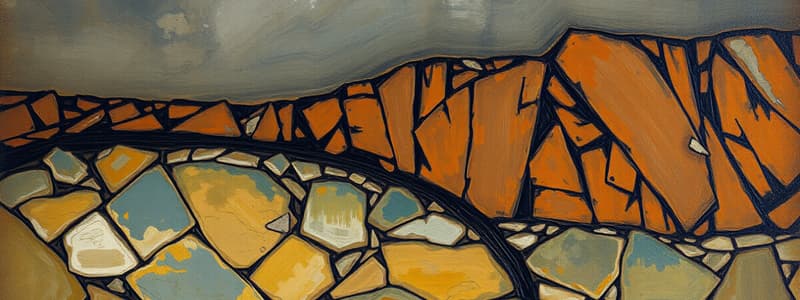Podcast
Questions and Answers
On the Relative Age Dating Lab Instructions and worksheet, study Figure 6. In Figure 6, the age sequence of the rocks, from oldest to youngest is ________.
On the Relative Age Dating Lab Instructions and worksheet, study Figure 6. In Figure 6, the age sequence of the rocks, from oldest to youngest is ________.
O, H, B, L, J, A, F, M, D, G, N, E, I, C, K
The relative ages of igneous rocks can be determined using which of the following? Choose ALL of the correct answers.
The relative ages of igneous rocks can be determined using which of the following? Choose ALL of the correct answers.
- Inclusions (correct)
- Cross-cutting relationships (correct)
- Contact metamorphic zones (correct)
- All of the above
The Principle of Fossil/Faunal Succession states that groups of fossil plants and animals occur in the geologic record in a definite and determinable order.
The Principle of Fossil/Faunal Succession states that groups of fossil plants and animals occur in the geologic record in a definite and determinable order.
True (A)
On the Relative Age Dating Lab Instructions and worksheet, study Figure 4. The geologic history revealed in Figure 4 is as follows: Layers G, C, A and F were deposited. A normal fault B cut layers G, C, A and F. A period of erosion followed which created an unconformity. F was completely eroded away except in the area where it had been down-faulted. H, D and I were deposited and finally, Fault E occurred.
On the Relative Age Dating Lab Instructions and worksheet, study Figure 4. The geologic history revealed in Figure 4 is as follows: Layers G, C, A and F were deposited. A normal fault B cut layers G, C, A and F. A period of erosion followed which created an unconformity. F was completely eroded away except in the area where it had been down-faulted. H, D and I were deposited and finally, Fault E occurred.
On the Relative Age Dating Lab Instructions and worksheet, study Figure 5. In Figure 5, the age sequence of the rocks, from oldest to youngest is ________.
On the Relative Age Dating Lab Instructions and worksheet, study Figure 5. In Figure 5, the age sequence of the rocks, from oldest to youngest is ________.
On the Relative Age Dating Lab Instructions and worksheet, study Figure 3. In Figure 3, the age sequence of the rocks, from oldest to youngest is ________.
On the Relative Age Dating Lab Instructions and worksheet, study Figure 3. In Figure 3, the age sequence of the rocks, from oldest to youngest is ________.
The Principle of Superposition states that, in a sequence of undeformed sedimentary rocks, the youngest beds are on the bottom of the sequence.
The Principle of Superposition states that, in a sequence of undeformed sedimentary rocks, the youngest beds are on the bottom of the sequence.
On the Relative Age Dating Lab Instructions and worksheet, study Figure 2. In Figure 2, the age sequence of the rocks, from oldest to youngest is ________.
On the Relative Age Dating Lab Instructions and worksheet, study Figure 2. In Figure 2, the age sequence of the rocks, from oldest to youngest is ________.
On the Relative Age Dating Lab Instructions and worksheet, study Figure 4. In Figure 4, the age sequence of the rocks, from oldest to youngest is ________.
On the Relative Age Dating Lab Instructions and worksheet, study Figure 4. In Figure 4, the age sequence of the rocks, from oldest to youngest is ________.
On the Relative Age Dating Lab Instructions and worksheet, study Figure 1. In Figure 1, the age sequence of the rocks, from oldest to youngest is ________.
On the Relative Age Dating Lab Instructions and worksheet, study Figure 1. In Figure 1, the age sequence of the rocks, from oldest to youngest is ________.
Flashcards are hidden until you start studying
Study Notes
Relative Age Dating Principles
- Relative Age Sequence: Different figures present varying sequences of rock ages, highlighting the importance of identifying the chronological order of geological formations.
- Principle of Fossil/Faunal Succession: This principle confirms that fossilized remains are found in a specific and predictable order through the geological record, aiding in dating rock layers.
- Principle of Superposition: Incorrectly suggests that younger sedimentary rock layers lie below older ones; in reality, the youngest layers are on top in an undeformed sequence.
Methods for Determining Relative Ages
- Inclusions: Rock fragments found within another rock can provide insights into relative ages.
- Cross-Cutting Relationships: Any geological feature that cuts through another is younger than the feature it disrupts.
- Contact Metamorphic Zones: These areas indicate that rocks underwent metamorphic processes after being formed, giving hints about their relative ages.
Examining Geological Figures
- Figure 1: Age sequence from oldest to youngest is C, E, D, A, B.
- Figure 2: Age sequence from oldest to youngest is E, B, C, D, A.
- Figure 3: Age sequence from oldest to youngest is C, A, B.
- Figure 4: Age sequence shows G, C, A, F, B, H, D, I, E; features a normal fault and eroded layers.
- Figure 5: Age sequence is D, H, A, C, G, F, I, B, E.
- Figure 6: Age sequence is O, H, B, L, J, A, F, M, D, G, N, E, I, C, K.
Geological Events
- Geologic history involves deposits, faults, and erosion that create unconformities; understanding these sequences is essential for interpreting rock layer histories.
Studying That Suits You
Use AI to generate personalized quizzes and flashcards to suit your learning preferences.




